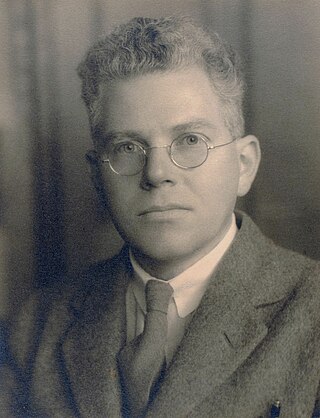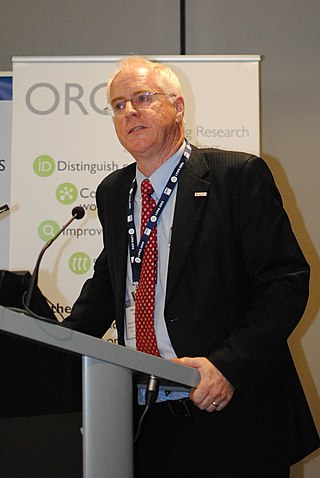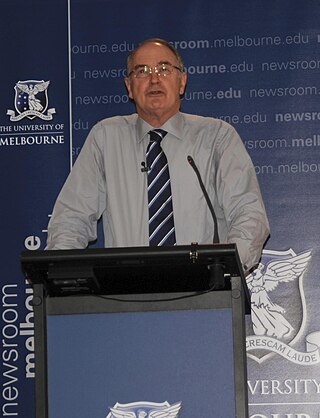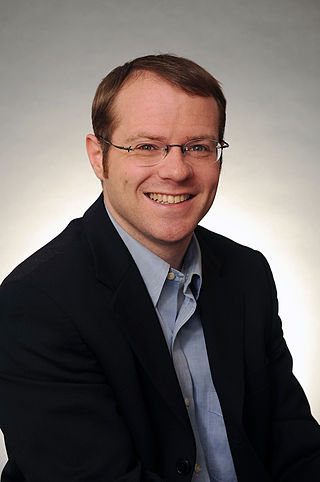Related Research Articles

The Australian National University (ANU) is a public research university and member of the Group of Eight, located in Canberra, the capital of Australia. Its main campus in Acton encompasses seven teaching and research colleges, in addition to several national academies and institutes.

Sir Marcus Laurence Elwin Oliphant, was an Australian physicist and humanitarian who played an important role in the first experimental demonstration of nuclear fusion and in the development of nuclear weapons.

Keith Alexander Nugent FAA is an Australian physicist. He is the Deputy Vice-Chancellor of the Australian National University (ANU) in Canberra.

Brian Paul Schmidt is the Vice-Chancellor of the Australian National University (ANU). He was previously a Distinguished Professor, Australian Research Council Laureate Fellow and astrophysicist at the University's Mount Stromlo Observatory and Research School of Astronomy and Astrophysics. He is known for his research in using supernovae as cosmological probes. He currently holds an Australian Research Council Federation Fellowship and was elected a Fellow of the Royal Society (FRS) in 2012. Schmidt shared both the 2006 Shaw Prize in Astronomy and the 2011 Nobel Prize in Physics with Saul Perlmutter and Adam Riess for providing evidence that the expansion of the universe is accelerating, making him the only Montana-born Nobel laureate.

Sir Ernest William Titterton was a British nuclear physicist.

Steven Chu is an American physicist and former government official. He is a Nobel laureate and was the 12th U.S. secretary of energy. He is currently the William R. Kenan Jr. Professor of Physics and Professor of Molecular and Cellular Physiology at Stanford University. He is known for his research at the University of California, Berkeley, and his research at Bell Laboratories and Stanford University regarding the cooling and trapping of atoms with laser light, for which he shared the 1997 Nobel Prize in Physics with Claude Cohen-Tannoudji and William Daniel Phillips.

Mark Diesendorf is an Australian academic and environmentalist, known for his work in sustainable development and renewable energy. He currently teaches environmental studies at the University of New South Wales, Australia. He was formerly professor of environmental science and founding director of the Institute for Sustainable Futures at the University of Technology, Sydney and before that a principal research scientist with CSIRO, where he was involved in early research on integrating wind power into electricity grids. His most recent book is Sustainable Energy Solutions for Climate Change.

Ross Gregory Garnaut is an Australian economist, currently serving as a vice-chancellor's fellow and professorial fellow of economics at the University of Melbourne. He is the author of numerous publications in scholarly journals on international economics, public finance and economic development, particularly in relation to East Asia and the Southwest Pacific.

Benjamin K. Sovacool is an American academic who is director of the Institute for Global Sustainability at Boston University as well as Professor of Earth and Environment at Boston University. He was formerly Director of the Danish Center for Energy Technology at the Department of Business Development and Technology and a professor of social sciences at Aarhus University. He is also professor of energy policy at the University of Sussex, where he formerly directed the Center on Innovation and Energy Demand and the Sussex Energy Group. He has written on energy policy, environmental issues, and science and technology policy. Sovacool is also the editor-in-chief of Energy Research & Social Science.

Benjamin John Eggleton FAA, FTSE, FOSA, FIEEE, FSPIE, FAIP, FRSN is Pro Vice Chancellor (Research) at the University of Sydney. He is also Professor in the School of Physics where he leads a research group in photonics, nanotechnology and smart sensors and serves as co-director of the NSW Smart Sensing Network (NSSN).

Professor Hans-Albert Bachor is a German-born Australian research physicist.
The Warren Centre for Advanced Engineering is an Australian engineering and science policy think-tank, established in 1983 and named for Australia's first engineering lecturer. The Sydney-based centre describes itself as Australia’s premier independent think-tank on transformative engineering issues.
Michael Miles Gore was a British-born Australian engineer, physicist, and science explainer, who worked at the Australian National University in Canberra. He was noted for being the founder of Questacon, the first interactive science centre in Australia.

Tony Irwin is a nuclear engineer and technical director of Australian company, SMR Nuclear Technology. For three decades he worked commissioning and operating nuclear reactors in the UK for British Energy. He emigrated to Australia in 1999 and took a position with the Australian Nuclear Science and Technology Organisation (ANSTO), where he remained for ten years. Irwin chairs the Nuclear Engineering Panel of Engineers Australia and lectures at the Australian National University and University of Sydney on nuclear science. Irwin has a degree in electrical power engineering.
Timothy John Stone, CBE is a British businessman and senior expert adviser with interests in infrastructure, finance, nuclear power and water supply. He is a non-executive director of the Arup Group, chairman of Nuclear Risk Insurers and former non-executive director of Horizon Nuclear Power and a former senior expert non-executive director on the board of the European Investment Bank. He was also a non-executive director of Anglian Water from 2011 to 2015. He was appointed Chair of the UK's Nuclear Industry Association in October 2018.
Chennupati Jagadish, an Indian-Australian physicist and academic, is the President of the Australian Academy of Science, and a Distinguished Professor of Physics at the Australian National University Research School of Physics. He is head of the Semiconductor Optoelectronics and Nanotechnology Group which he established in 1990. He is also the Convener of the Australian Nanotechnology Network and Director of Australian National Fabrication Facility ACT Node.
The Energy Change Institute is a research centre at the Australian National University in Canberra, dedicated to the study of "carbon free forms of energy production" and their application in response to climate change. It focuses on energy research and education ranging from "the science and engineering of energy generation and energy efficiency, to energy regulation, economics, sociology, security and policy." The ECI claims to be technology and policy neutral. The ECI maintains a close relationship with its sister organisation, the ANU Climate Change Institute and shares a common secretariat. The institute's director is Professor Kenneth Baldwin.
David Ernest McClelland is an Australian physicist, with his research focused on the development of the manipulation and control of optical quantum states, and its implementation into gravitational wave observatories. He is a Fellow of the Australian Academy of Science, the American Physical Society and the Optical Society of America. Since 2001, he has been a professor at the Australian National University (ANU) in the Research School of Physics and Engineering, in Canberra (Australia). He is Director of the ANU's Centre for Gravitational Astrophysics and Deputy Director of OzGrav - the Australian Research Council Centre of Excellence in Gravitational Wave Discovery.
Frank Jotzo is a professor at the Australian National University's Crawford School of Public Policy, Head of Energy at the ANU Institute for Climate, Energy & Disaster Solutions, Director for the ANU Zero Carbon Energy for Asia-Pacific Grand Challenge initiative and Director of the Centre for Climate Economics and Policy at Australian National University. As an environmental economist, his research focuses on policy relevant aspects of climate change, energy, and broader issues of environment, development and economic reform.

Elanor H. Huntington is Executive Director of Digital, National Facilities & Collections at the Commonwealth Scientific and Industrial Research Organisation and a Professor of Quantum Cybernetics at the Australian National University. She led a research program in the Australian Research Council Centre of Excellence for Quantum Computation and Communication Technology.
References
- ↑ Director (Research Services Division). "Professor Kenneth Baldwin". researchers.anu.edu.au. Retrieved 17 May 2016.
- ↑ "Light, Energy and the Environment Congress". The Optical Society. Retrieved 18 May 2016.
- ↑ "Professor Kenneth Baldwin FTSE". Australian Academy of Technology & Engineering. Retrieved 26 November 2021.
- ↑ "Past Winners & Finalists (Eureka Prizes) - Australian Museum". australianmuseum.net.au. Retrieved 17 May 2016.
- ↑ "Science meets Parliament". Science & Technology Australia. 3 December 2014. Retrieved 17 May 2016.
- ↑ Director, SCAPA; media@anu.edu.au. "Enhancing Public Policy at ANU - From the Vice-Chancellor's desk - ANU" . Retrieved 17 May 2016.
- ↑ "ANU ENERGY UPDATE presents the World Energy Outlook 2013". ECI. 1 November 2013. Retrieved 17 May 2016.
- ↑ "2015 ANU Energy Update". ECI. 22 December 2015. Retrieved 17 May 2016.
- ↑ Australia Energy Technology Assessment 2012 (PDF). Canberra, Australia: Australian Government Bureau of Resources & Energy Economics. 2012. pp. iii. ISBN 978-1-922106-29-2.
- ↑ "Disclosure of Potentially Relevant Roles & Interests – Socio-Economic Modelling Advisory Committee | Nuclear Fuel Cycle Royal Commission". nuclearrc.sa.gov.au. Retrieved 17 May 2016.
- ↑ "SA royal commission on nuclear energy sparks calls for discussion to go national". Australian Broadcasting Corporation . 9 February 2015. Retrieved 24 June 2015.
- ↑ "Geothermal and nuclear energy". Radio National. Retrieved 24 June 2015.